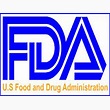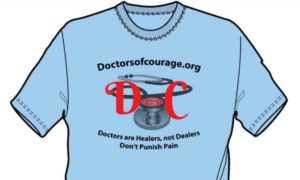 In their “plan”, they state “The FDA is deeply concerned about the growing epidemic of opioid abuse, dependence and overdose in the United States. In response to this crisis, the agency has developed a comprehensive action plan to take concrete steps toward reducing the impact of opioid abuse on American families and communities.”
In their “plan”, they state “The FDA is deeply concerned about the growing epidemic of opioid abuse, dependence and overdose in the United States. In response to this crisis, the agency has developed a comprehensive action plan to take concrete steps toward reducing the impact of opioid abuse on American families and communities.”
But their focus is still on their misconception that opiates cause addiction. Their only “plan” involves labeling opiates with warning labels, creating more hurdles for new opioid approvals, and pushing abuse-deterrent formulations.
In trying to persuade physicians from prescribing opiates for pain, they are using the current government position that there is no evidence that long-term use of opioids is effective. Excuse me? Opiates have been used for centuries for pain. But they are basing their statement on the absence of “controlled studies”. Well, we don’t have controlled studies on the effectiveness of Aspirin on fever either, but we know it works. Hopefully their requiring companies to do the studies will show that opiates work the best for chronic pain with the least risk. The problem is that controlled studies basically prove whatever the designer sets out to prove. Since the money will be in studies that prove lies about opiates, that is probably what we will see—lies.
The following breakdown of the points of the plan are copied and discussed.
FDA’s actions also include:
-
Expand use of advisory committees with the expected outcome of reviewing any new opioid that does not have abuse-deterrent properties and expert advice on pediatric opioid labeling.
-
Develop warnings and safety information for immediate-release (IR) opioid labeling similar to the extended-release/long-acting (ER/LA) opioids now in effect. The expected outcome is information for doctors about the risks and how to prescribe safely.
Potential for more attacks on doctors for prescribing “outside the usual course of practice”.
-
Strengthen postmarket requirements, requiring drug companies to generate postmarket data on the long-term impact of using ER/LA opioids. Outcome: Better evidence on the serious risks of misuse and abuse associated with long-term use of opioids, predictors of opioid addiction and other important issues.
Here they are being quite obvious in what they want these studies to show, and so they will.
-
Update Risk Evaluation and Mitigation Strategy (REMS) Program. ER/LA opioids are currently subject to a REMS program that requires sponsors to fund continuing medical education (CME) providers to offer, at low or no cost, CME courses on the appropriate use of these products. The FDA will update the REMS program requirements for opioids after considering advisory committee recommendations and review of existing requirements. Outcome: Increase the number of prescribers who receive training on pain management and safe prescribing of opioid drugs in order to decrease inappropriate opioid prescribing.
Again, another potential way to attack doctors. Either they haven’t taken these courses, putting them at risk for charges, or they have, and the government can charge them with not following the protocols.
-
Expand access to abuse-deterrent formulations (ADFs) to discourage abuse. The pharmaceutical industry has shown significant interest in developing ADFs and the technology is progressing rapidly. ADFs hold promise as their abuse-deterrent qualities continue to improve and as they become more widely available. The FDA will issue draft guidance with its recommendations for the approval standards for generic abuse-deterrent formulations. Release of this guidance is a high priority, since the availability of less costly generic products should accelerate prescribers’ uptake of ADFs. Outcome: Spur innovation and generic ADF product development.
This provision shows the best promise for actually doing something good. If we can provide opiates that are actually impossible to abuse, then switching to these for real medical issues can decrease the use of prescription drugs for illegal purposes and at the same time, provide legitimate patients with real treatment. But the key here is cost. If these drugs are not made available to the poor, government insured and uninsured at reasonable cost, they will still not affect the majority of the population.
-
Support better treatment. The FDA is reviewing options, including over-the-counter availability, to make naloxone more accessible to treat opioid overdose, building on the agency’s recent approval of intranasal naloxone.
The government seems to think that the answer to drug abuse is simply to give everyone the antidote. This is really backwards thinking at its prime.
“The agency actively supports the Centers for Disease Control and Prevention guidelines for prescribing opioids for the treatment of pain and will facilitate the development of evidence and improved treatments.”
In my opinion, this is a lie. The government isn’t really interested in the development of improved treatments. There have been improved treatments for pain for decades now, and the government won’t pay for them. Prolotherapy for example.
-
Reassess the risk-benefit approval framework for opioid use. The FDA will seek advice from the agency’s Science Board in March 2016 and is already engaging the National Academies of Sciences, Engineering, and Medicine on how to take into account our evolving understanding of the risks of opioids, not only to the patient but also the risks of misuse by other persons who obtain them.
This is the real danger of this entire plan. We already know the government’s stand on the use of opioids. It is my opinion that the purpose of this plan is to pave the way to completely outlaw the use of opioids entirely for chronic pain. We will be forced into the old “live with it” treatment plan. Time will tell.
Linda Cheek is a teacher and disenfranchised medical doctor, turned activist, author, and speaker. A victim of prosecutorial misconduct and outright law-breaking of the government agencies DEA, DHHS, and DOJ, she hopes to be a part of exonerating all doctors illegally attacked through the Controlled Substance Act. She holds the key to success, as she can offset the government propaganda that drugs cause addiction with the truth: The REAL Cause of Drug Abuse.
Get a free gift to learn how the government is breaking the law to attack your doctor: Click here to get my free gift


Title : Government’s horrible War On Prescription Opiate pain medication.
I have taken this opportunity to share my heartbreaking story in hopes these witch hunting Opiate ill informed skeptics will read and understand that I would have no life without Medically prescribed Opiates by a physicians care and strictly monitored monthly urine and blood test. Please remember that An Opinion Before A Thorough Investigation Is The Epitome Of Ignorance! And that a little more compassion from the Medical Field and its representatives could have saved my beautiful Stepdaughters life. Let me say this! A person who has a addictive personality will abuse anything that helps them feel better. I have taken Oxycontin for 12 years , I have had 26 major surgery’s in the past 9 years. I have so much physical pain I can not even get out of bed with out pain medication and when I run out I run out and just lay in bed praying the Lord relieve me of this horrible condition and I pray God you medically prescribed Opiate Pain medication skeptics never go through what I go through everyday of my life when the only thing you have to do is threaten what help I get, Shame on you! There will always be drug abuse and as the so called war on drugs has failed miserably every since the Government declared it. Now ,all this is doing is giving help and aid to the illegal Heroin cartel’s and drug pushers business pushing them to knew heights in the Black Market of Heroin while depriving folks as me of relief . Trying to label us legitimate Chronic Pain Sufferers as some type of Junkie and trying to align Chronic Pain Sufferers with Heroin Addicts in this horrible Witch Hunt !
My Stepdaughter committed suicide 4 years ago because of being treated like a drug addict by some of her family , friends and doctors when all along she suffered from Lupus and Fibromialgia which I believe was brought on by a deadly car crash at 18 , she told me between that which I was being put through and what they were putting her through She was not going to live her life in such a hell brought on by people like these Opiate Pain Medication Witch hunters that are on a witch hunt to out law Opiate pain medications that give us Chronic Pain sufferers some sort of a life . As a retired Police officer and worked directly close to the DEA, these people do not have a clue how thrilled they are making the illegal Heroin trade and think of my Late Stepdaughter as they continue on with this Witch Hunt movement to outlaw opiates! Just like the slaughter of The 20 Children and 5 Teachers at Sandy Hook Elementary School, if there would have just been gun laws , my God they were Gun Laws , the guns that murdered all those 20 children were all registered and owned by a school teacher! You fight Drug Addiction in Elementary education by teaching all children the dangers of Booze and Tobacco which if these witch hunters want for us to know the real truth but they do not. I miss my Stepdaughter so much and some of us will continue on with the fight to protect our right to feel better and function without fear of these witch hunters trying to convince us to commit suicide or be forced to street drugs or the Legal government Boozers . And they are trying to do exactly THAT!
The under line real truth is THESE witch hunters would rather us Chronic Pain sufferers commit suicide are and DRINK all the BOOZE we can drink! The Federals legalized ( ALCOHOL) knowing its a more deadly drug than Strychnine. And just because the DEA has miserably failed with their war on illegal drugs why do they want to deprive us sick people of our Constitutional Rights to be Happy in that pursuit of with Professional Physicians monitoring legally prescribed Opiate Pain Medicines that give us relief of this horrible malady of Chronic Pain ! May God have mercy on their miserable souls they that seek to destroy us Chronic Pain Sufferers only and little hope of temporary relief of this horrible sickness.
“But they are basing their statement on the absence of “controlled studies”. Well, we don’t have controlled studies on the effectiveness of Aspirin either, but we know it works. ”
That statement is not true. Saying there isn’t is no better than the misinformation the govt and big pharma do …
Please point me to the studies on aspirin for reducing temperature. I did mean that specifically, and have changed the post. But in my training this was pointed out, and I don’t know of anything recent.
This doesn’t help us legitimate Ronnie pain patients at all. As we all know even the so called abuse deterrent OxyContin they’ve (the addicts) have found ways to abuse them, while the reformulated OxyContin for example doesn’t work nearly as well as the previous OxyContin did, yet they’re (the addicts) are still abusinng them. When will the government look at the Patients access to opiates bill that’s been sitting since 4/2015 and approved by the senate in March 2016 changed a few words and now is back to the house to vote on? How long will that and other bills that will help us true “Chronic Pain Patients” gain access to the medication we were told by our pain physicians 90 days ago, due to the misguided CDC recommendations of the CDC meant for pcp’s only, yet now implemented by our pain physicians be looked at. I for one was told I had 90 days to either comply with a much lower dose then what I’ve been prescribed for many years that kept me a functioning member of society and working at the age of 53, realize that the DEA is causing with patients harm and the physicians are going against their Hippocrates Oath to do no harm? I am now without a provider as they all fear the DEA as they are not even accepting new patients nor are they writing what I and many others need to function. I assume I will be in withdrawal soon as I’m out of medications May 2, 2016 and without a physician to prescribe me anything. I’ve never asked to be increased, followed my providers contract faithfully for years, passed me urine drug screens and cannot find another physican in time before it’s too late. Will it take increased suicides over not having our medications needed and not abused or addicted as an addict is when the pain we face daily increases to the point we can’t take it for them to consider the chronic pain patient who need their medications, more social security patients due to one cannot work or function, or worse yet turning to the illicit drug market not knowing what one will get killing us for seeking medications we know nothing about, thus making those that are diverting the medications we need even more prevalent. Where do we go from here when the DEA is not allowing the physicians with the medical educations to treat us properly as they’re (the government) are clearly prescribing our treatment without a license, which I know is against the law. Those in government or anyone in the DEA, CDS, FDA, HHS or anyone else involved in these regulations and new laws without medical decrees re clearly telling the physicians how to practice medicine and the physicians again are in fear of not having a DEA license, that they’re listening to rules not even intended for them.